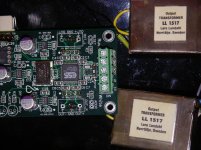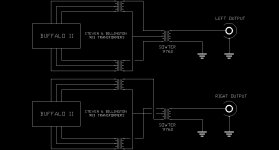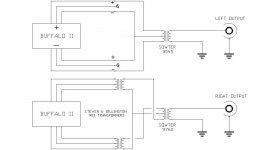Would it be ok to interpret it like this...
With a very low impedance load the dac operates as fairly close to a perfect curent source with very good numbers (THD and such).
As soon as the load impedance starts to rise the numbers start to drop but the drop is reversed exponential, i.e. the drop is most prenounced in the begining and when the load impedance starts to get into the high numbers the differences are very small.
The big difference is when the dac cannot operate as a ideal current source and the load impedance is lowish but not really low. As soon as the load impedance passes an arbitrary number it becomes not so critical.
The difference between 2ohm and 10ohm is big as well as 10 vs 100ohm but the difference between 1kohm and 10kohm is small while 10kohm vs 1Mohm doesn't really matter all that much?
With a very low impedance load the dac operates as fairly close to a perfect curent source with very good numbers (THD and such).
As soon as the load impedance starts to rise the numbers start to drop but the drop is reversed exponential, i.e. the drop is most prenounced in the begining and when the load impedance starts to get into the high numbers the differences are very small.
The big difference is when the dac cannot operate as a ideal current source and the load impedance is lowish but not really low. As soon as the load impedance passes an arbitrary number it becomes not so critical.
The difference between 2ohm and 10ohm is big as well as 10 vs 100ohm but the difference between 1kohm and 10kohm is small while 10kohm vs 1Mohm doesn't really matter all that much?
About transformers you must remember RDC is added to the output impedance. So going 2:1 could be be a good thing. Must say I don´t think 600:600 is the best solution. Example using LL1690 that can be looked upon as a very good 10k:10k :
1:1, Zout from DAC=195ohm, RDC of transformer 150+150ohm each side, Zout will be 195+300+300=795ohm.
2:1, Zout from DAC=195ohm primary RDC=150+150ohm . This is overreduced to the secondary as 495/4=124ohm. The secondary windings are now parallelled giving a RDC of 150/2=75ohm. This gives a total of Zout 124+75=199ohm which is a useful figure.
Output level will be low though as DAC ouput is only 3,3Vpp. This means 0,6Vrms when going 2:1.
1:1, Zout from DAC=195ohm, RDC of transformer 150+150ohm each side, Zout will be 195+300+300=795ohm.
2:1, Zout from DAC=195ohm primary RDC=150+150ohm . This is overreduced to the secondary as 495/4=124ohm. The secondary windings are now parallelled giving a RDC of 150/2=75ohm. This gives a total of Zout 124+75=199ohm which is a useful figure.
Output level will be low though as DAC ouput is only 3,3Vpp. This means 0,6Vrms when going 2:1.
Last edited:
Now it we want to use BufII in voltage mode, imput impedance of transformer should be many times higher than 195ohm so maybe trafo 10k:10k will be better choice than 600:600?
The reason is that the big difference between using 600 and 10K is going to be voltage loss. 🙂 You will have over 2VRMs either way. So nothing to worry about.
I am not here to try to persuade you that using transformers is a bad idea. Far from it, I am trying to explain what I might do if I were using one. But I would probably try lot of things. And so should you. 🙂
Cheers!
Russ
Last edited:
over 2VRMs either way
Hey Russ,
I used the Sabre datasheet to find my figures. Has 9018 higher output?
No the output is the same. About 2.2VRMS(depending on AVCC) differential. 🙂
So you might come in just under 2VRMS depending on the transformer you use, but not enough to worry over. 🙂
So you might come in just under 2VRMS depending on the transformer you use, but not enough to worry over. 🙂
Hey Russ,
Is the datasheet wrong?
This is from the 9008 datasheet running AVCC of 3,3V. How do you make 2Vrms out of that? The spec says 3,3Vpp that without a doubt corresponds to 1,17Vrms.
If the sheet is right, going for 5V should give us 1,77V.
Is the datasheet wrong?
This is from the 9008 datasheet running AVCC of 3,3V. How do you make 2Vrms out of that? The spec says 3,3Vpp that without a doubt corresponds to 1,17Vrms.
If the sheet is right, going for 5V should give us 1,77V.
Attachments
Last edited:
The datsheet is correct but you are summing (or rather differencing) the differential outputs.
Last edited:
This has gone OT and isn´t the most important thing in the world:
The datasheet says differential so the guys at ESS did a small spec mistake(but great DACs). They don´t single end. If we are kind we can call the specification diffuse.
I am still a little puzzled/impressed how they can make the single outputs 3,3Vpp swing fully up to the rails with 3,3V DACC.
Had to check a few others like Wolfson and CL and what they call differentiel output is between the phases(like it should) and in Wolfsons case is 2Vrms. Lets call that "Industry Standard".
Russ, I can admit one should be suspicious as the indicated Vout was very low. Great you could clarify. And also edited your first "not-so-very-selling" answer😉.
So back to basics, with a 2:1 we will get 1,2Vrms which is a perfectly acceptable.
I had a discussion with Kevin at K&K a while ago about what transformer to choose to my coming 9018 and he recommended LL1676 before LL1690 when going 2:1. But this one will give us a Zout of ca 600ohm due to higher RDC.
The datasheet says differential so the guys at ESS did a small spec mistake(but great DACs). They don´t single end. If we are kind we can call the specification diffuse.
I am still a little puzzled/impressed how they can make the single outputs 3,3Vpp swing fully up to the rails with 3,3V DACC.
Had to check a few others like Wolfson and CL and what they call differentiel output is between the phases(like it should) and in Wolfsons case is 2Vrms. Lets call that "Industry Standard".
Russ, I can admit one should be suspicious as the indicated Vout was very low. Great you could clarify. And also edited your first "not-so-very-selling" answer😉.
So back to basics, with a 2:1 we will get 1,2Vrms which is a perfectly acceptable.
I had a discussion with Kevin at K&K a while ago about what transformer to choose to my coming 9018 and he recommended LL1676 before LL1690 when going 2:1. But this one will give us a Zout of ca 600ohm due to higher RDC.
Yes, I am thinking the ESS datasheet simply used the wrong term. Not your fault for believing it. 🙂
Nice work. 🙂
io,
try this configuration:
secondary in series
8,2k across secondaries
100ohm across primaries
this should give about 2V output and DAC will see impedance about 12-13ohm (insted of about 20 in your case)
you can even try go into lower impedance (<10ohm): sec series, 3,1k, 13ohm and 1V output (if it is sufficient for your amp)
Marek
try this configuration:
secondary in series
8,2k across secondaries
100ohm across primaries
this should give about 2V output and DAC will see impedance about 12-13ohm (insted of about 20 in your case)
you can even try go into lower impedance (<10ohm): sec series, 3,1k, 13ohm and 1V output (if it is sufficient for your amp)
Marek
Buffalo and LL1517
Just to put my 2 cents and sign to the club of BuffaloII & Transformers.
I'm just playing with Buffalo and Lundahl LL1517.
On some aspects probably IVY is technically better output stage with lower distortion and probably more “details” but with transformers Buffalo is playing "smooth and easy".
You just don't wont it to stop playing. 😀 .
And also very nice thing is that Buffalo with LL1517 can drive directly HD650 with absolutely no problem. Great Sounding and “SUPER SIMPLE” HedAmp.
Anyway Buffalo is really great DAC and Russ and Brian are doing amazing job about it.
P.S.
If I could suggested to TP the only “right way” of mounting the AVC Shunt reg is of cause GLT way 😉.
This should be in Buffalo manual, specially when except of listening to Your DAC You intent to make an photo of it 😉.
All the best
Rosendorfer
Just to put my 2 cents and sign to the club of BuffaloII & Transformers.
I'm just playing with Buffalo and Lundahl LL1517.
On some aspects probably IVY is technically better output stage with lower distortion and probably more “details” but with transformers Buffalo is playing "smooth and easy".
You just don't wont it to stop playing. 😀 .
And also very nice thing is that Buffalo with LL1517 can drive directly HD650 with absolutely no problem. Great Sounding and “SUPER SIMPLE” HedAmp.
Anyway Buffalo is really great DAC and Russ and Brian are doing amazing job about it.
P.S.
If I could suggested to TP the only “right way” of mounting the AVC Shunt reg is of cause GLT way 😉.
This should be in Buffalo manual, specially when except of listening to Your DAC You intent to make an photo of it 😉.
All the best
Rosendorfer
Attachments
I asked a queston at the original Buffalo II thread about dual monos.
I was wondering if it would be possible to use transformers as the I/V output for dual monos?
Not sure about the resistance values I'd use across the primaries and secondaries.
I'd really like to not use an active I/V and Bal/Se combo for S.E. output
I came up with something like this:
Workable??
Jeff Davison
I was wondering if it would be possible to use transformers as the I/V output for dual monos?
Not sure about the resistance values I'd use across the primaries and secondaries.
I'd really like to not use an active I/V and Bal/Se combo for S.E. output
I came up with something like this:
Workable??
Jeff Davison
Attachments
You are correct about the 9762, just got a scheatic from Sowter to confirm.
I'll check out the 9545.
Will it need resistors on the primary or secondary to give the dac a needed reflected load?
Jeff
I'll check out the 9545.
Will it need resistors on the primary or secondary to give the dac a needed reflected load?
Jeff
Where can Sabre, woekable ? Sowter 9762 non center tap primer
io
- Status
- Not open for further replies.
- Home
- More Vendors...
- Twisted Pear
- Buffalo II & transformers



